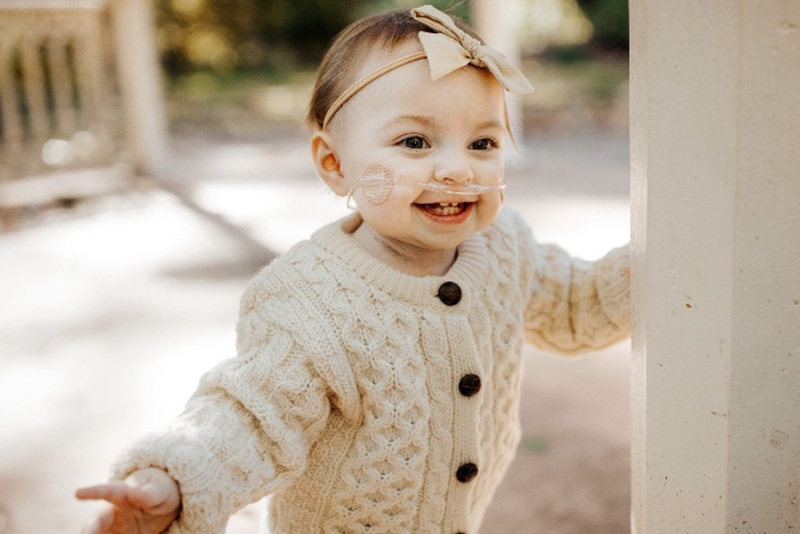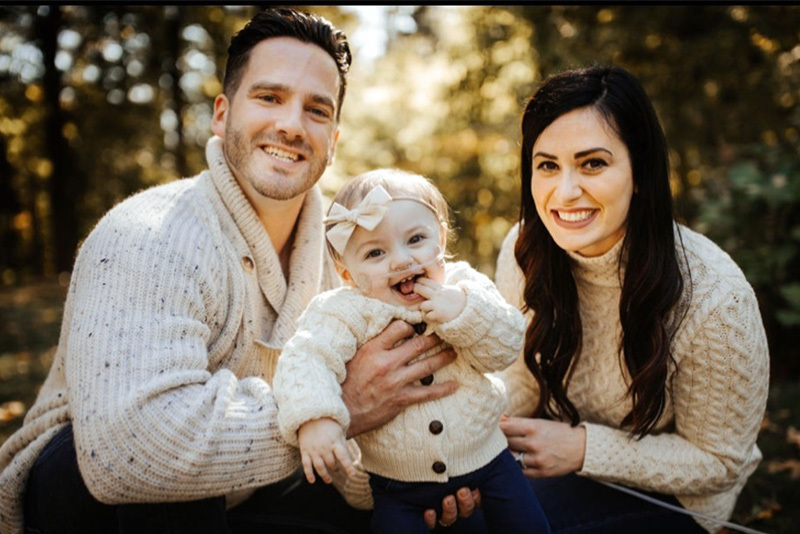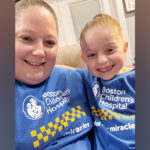Making it through the fight: Scarlett’s CDH journey

Like her name suggests, Scarlett Virginia Moulton “has a lot of fire,” says her mother, Olivia. “She always has a smile on her face. We tell her every day how strong she is and she just smiles. It’s almost like she knows she’s made it through the big fight.”
That fight began even before Scarlett was born. Originally diagnosed with a congenital pulmonary airway malformation while she was still in the womb, Scarlett was born five weeks early. But not long after her birth, it was clear she had been misdiagnosed. Instead, testing revealed that she had a right-sided congenital diaphragmatic hernia (CDH).

A surprising diagnosis
CDH is a rare and life-threatening condition in which the diaphragm, the muscle that the body uses to breathe, does not form completely, and leaves a hole between the chest and abdominal cavity. This can cause the intestines and other abdominal organs to move into the chest, which prevents normal lung development. Although Olivia, who works as a respiratory therapist, had heard of CDH, she wasn’t thoroughly familiar with its treatment. Her family reached out to Boston Children’s Hospital for care.
In less than 48 hours, the Boston Children’s transport team had arrived at the Moultons’ local hospital to pick her up. “It was the best feeling,” says Olivia. “We knew we made the right call and Scarlett would be in good hands.”

A marathon, not a sprint
What Olivia and her husband, Jonathan, couldn’t have imagined was that their daughter would spend a total of 167 days in the hospital. Surgery by Dr. Christopher Weldon in October 2019 successfully repaired Scarlett’s CDH. Although her health then took an unexpected turn, the team had prepared the couple that CDH babies all have different courses.
As a result, Scarlett was put on ECMO for more than a month to help support her heart and lungs while she recovered. But then she had a stroke while on ECMO — a potential complication of long-term ECMO. Olivia and Jonathan learned that Scarlett might not survive and that the next few days would be critical. Even though they knew she needed to get off of ECMO, she wasn’t ready yet.
“We were always in a tight race, but the race kept getting tighter the longer she stayed on,” says Olivia.
“I remember asking Dr. Weldon, ‘What if she dies? How does anyone ever come back from that?’” says Olivia. “He told me, ‘You put two feet on the ground, live in the present, give it time, and let me worry about everything else.’”
Indeed, the Moultons found that patience was key. In the end, Scarlett remained on ECMO for several more days, yet so far shows no lasting signs of having had a stroke. “Things got better with each month,” Olivia remembers. “We knew we were in for a marathon, not a sprint.”

Ready to take on the world
By March 2020, Scarlett was finally ready to come home — but she and her family were about to face new challenges. The week after she was discharged, the country went into lockdown for the COVID-19 pandemic. Now, like countless other families, they found themselves in a new type of isolation.
Through it all, Scarlett has maintained a fierce, positive attitude in spite of — or perhaps because of — what she’s endured. She’s hitting her milestones and sees Dr. Jill Zalieckas and the team at the Congenital Diaphragmatic Hernia Program regularly, as well as other clinicians at Boston Children’s.
“The fact that she not only survived but has also thrived is amazing,” says Olivia. “It’s like she’s ready to take on the world.”
Learn more about the Congenital Diaphragmatic Hernia Program.
Related Posts :
-

Hard and beautiful at the same time: Five lessons of raising a medically complex child
When they learned they were expecting a baby, Michelle and Stephen Strickland were delighted. The South Carolina couple looked forward ...
-

‘Challenge accepted’: Sophia takes on a brain tumor
In 2023, Sophia Mordini landed the role of a lifetime. A competitive dancer, the 12-year-old would play Clara in her company’...
-

After surgeries to treat HLHS, Carter is healthy and happy at home in Florida
Carter Miller loves action. The 4-year-old Florida resident enjoys riding on golf carts and flying high on swing sets. ...
-

Unveiling the hidden impact of moyamoya disease: Brain injury without symptoms
Moyamoya disease — a rare, progressive condition that narrows the brain’s blood vessels — leads to an increased risk of stroke ...





